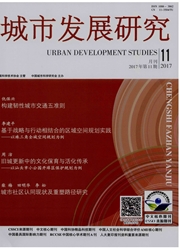

 中文摘要:
中文摘要:
人户分离群体是城市化背景下城市空间研究的特殊群体和典型样本之一.以南京主城区为例,以第六次全国人口普查的数据为依据,从三个层面探析了人户分离群体的空间特征:其一、在空间聚集方面,通过比重、密度等典型指标来表征人户分离群体空间的总体结构,并基于“密度指数”与“比重指数”的测度,将人户分离群体空间划分为三级聚集区;其二、在特征分布方面,从户籍、性别、分离时间、教育程度等方面来测度和图解人户分离群体社会属性的空间特征;其三、在交叉分析方面,则发掘了人户分离群体各项社会属性之间的不同关联性.最后,探讨了影响人户分离的个体原因和环境因素.
 英文摘要:
英文摘要:
Population separate between registered and actual residences is one of the particular groups and significant stylebooks for the analysis on urban space in Chinese urbanization. Based on the case study in main city of Nanjing, the paper manages to analyze the spatial characteristics in such aspects : firstly, to describe the total spatial structure of population separate between registered and actual residences, and to divide the employment accumulation areas by means of density index and proportion index; secondly, to measure and illustrate the social space characteristics of population separate between registered and actual residences by means of census register, sexual distinction, separate time, educational degree and so on; thirdly, to explore the different correlations between social attributes of population separate between registered and actual residences by means of cross-analysis; eventually, to discuss the individual and environmental reasons for population separate between registered and actual residences.
 同期刊论文项目
同期刊论文项目
 同项目期刊论文
同项目期刊论文
 期刊信息
期刊信息
